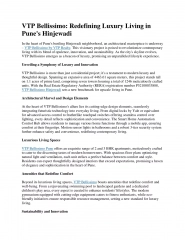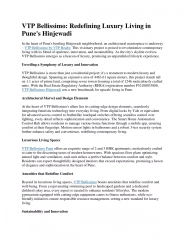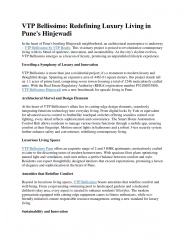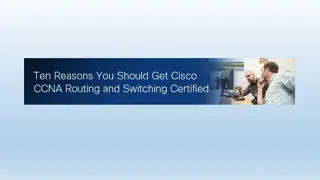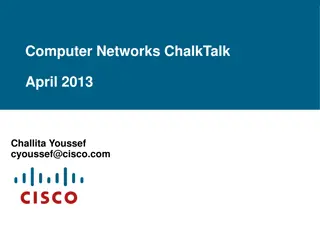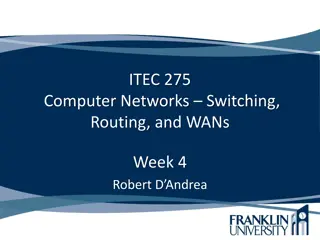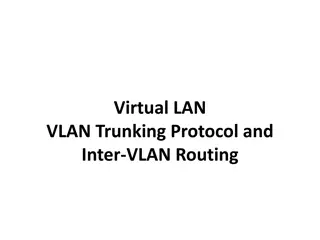
VLAN Trunking Protocol (VTP)
Explore the VLAN Trunking Protocol (VTP), a Cisco proprietary protocol used for efficient VLAN management across network switches. Learn about VTP modes, domain configuration, and the benefits of VTP pruning for optimizing network bandwidth usage.
Download Presentation

Please find below an Image/Link to download the presentation.
The content on the website is provided AS IS for your information and personal use only. It may not be sold, licensed, or shared on other websites without obtaining consent from the author. If you encounter any issues during the download, it is possible that the publisher has removed the file from their server.
You are allowed to download the files provided on this website for personal or commercial use, subject to the condition that they are used lawfully. All files are the property of their respective owners.
The content on the website is provided AS IS for your information and personal use only. It may not be sold, licensed, or shared on other websites without obtaining consent from the author.
E N D
Presentation Transcript
Introduction -VTP is a cisco proprietary Protocol -Used to share VLAN information across multiple switches and to maintain consistency throughout the network.
VTP 1. VTP Manages the addition, deletion and renaming of VLANs across the network from a central point of control 2. Information will be passed only if switches are connected with fast Ethernet ports or higher ports. 3. Ports connecting switches must be trunk ports. 4. VTP Domain must be the same (Domains are not case sensitive)
Domain: class Password (optional)
VTP Modes Client Server Transparent 5. There must be a server (were all changes are made) 6. Clients (all other switches receiving orders from the server) 7. Transparent receive information from the server and pass them over to neighboring switches. They are authoritative to themselves
Client Server Client Client
Client Server Transparent Transparent
Server Mode (read and write) You can have more than one Server 1. Default Mode 2. Create, Modifies and Delete VLANs 3. Synchronizes VLAN Configurations 4. Sends and Forwards advertisement 5. Saves Configuration in NVRAM Client Mode (read only) 1. Cannot add, modify and delete its VLAN configuration 2. Doesn t store its VLAN configuration in NVRAM(it learns it from the server at boot time) 3. Forwards Advertisement 4. Synchronizes VLAN configurations 5. Do not save in NVRAM
Transparent Mode 1. Can Add, modify and delete VLAN configurations 2. Does not synchronize VLAN configurations 3. Forwards advertisements 4. Saves configuration to NVRAM A transparent mode is the same as Server except for the fact that it doesn t synchronizes VLAN configurations
VTP Pruning VTP pruning enhances network bandwidth use by reducing unnecessary flooded traffic, such as broadcast, multicast, and unicast packets. VTP pruning increases available bandwidth by restricting flooded traffic to those trunk links that the traffic must use to access the appropriate network devices.
Question 1 Refer to the exhibit. After Switch B was added to the network, VLAN connectivity problems started to occur. What caused this problem? A. Both switches are in server mode in the same domain. B. The revision number of SwitchB was higher than the revision number of SwitchA. C. SwitchA was not rebooted prior to adding SwitchB to the network. D. V2-mode is not enabled. E. VTP pruning is not activated, so the new paths in the network have not been recalculated. B
Question 2 A network administrator is explaining VTP configuration to a new technician. What should the network administrator tell the new technician about VTP configuration? (Choose three) A. A switch in the VTP client mode cannot update its local VLAN database. B. A trunk link must be configured between the switches to forward VTP updates. C. A switch in the VTP server mode can update a switch in the VTP transparent mode. D. A switch in the VTP transparent mode will forward updates that it receives to other switches. E. A switch in the VTP server mode only updates switches in the VTP client mode that have a higher VTP revision number. F. A switch in the VTP server mode will update switches in the VTP client mode regardless of the configured VTP domain membership. A B D
Question 3 What are two benefits of using VTP in a switching environment? (Choose two) A. It allows switches to read frame tags. B. It allows ports to be assigned to VLANs automatically. C. It maintains VLAN consistency across a switched network. D. It allows frames from multiple VLANs to use a single interface. E. It allows VLAN information to be automatically propagated throughout the switching environment. C E
Question 4 What is the name of the VTP mode of operation that enables a switch to forward only VTP advertisements while still permitting the editing of local VLAN information? A. Server B. Client C. Tunnel D. Transparent D
Question 5 Which VTP mode is capable of creating only local VLANs and does not synchronize with other switches in the VTP domain? A. Client B. Dynamic C. Server D. Static E. Transparent E
Question 6 An administrator is unsuccessful in adding VLAN 50 to a switch. While troubleshooting the problem, the administrator views the output of the show vtp status command, which is displayed in the graphic. What commands must be issued on this switch to add VLAN 50 to the database? (Choose two) A. Switch(config-if)# switchport access vlan 50 B. Switch(config)#vtp mode server C. Switch(config)# config-revision 20 D. Switch(config)#vlan 50 name Tech E. Switch(vlan)# vlan 50 F. Switch(vlan)# switchport trunk vlan 50 B E
Question 7 To configure the VLAN trunking protocol to communicate VLAN information between two switches, what two requirements must be met? (Choose two) A. Each end of the trunk line must be set to IEEE 802.1E encapsulation. B. The VTP management domain name of both switches must be set the same. C. All ports on both the switches must be set as access ports. D. One of the two switches must be configured as a VTP server. E. A rollover cable is required to connect the two switches together. F. A router must be used to forward VTP traffic between VLANs. B D
Question 8 Which statements describe two of the benefits of VLAN Trunking Protocol? (Choose two) A. VTP allows routing between VLANs. B. VTP allows a single switch port to carry information to more than one VLAN. C. VTP allows physically redundant links while preventing switching loops. D. VTP simplifies switch administration by allowing switches to automatically share VLAN configuration information. E. VTP helps to limit configuration errors by keeping VLAN naming consistent across the VTP domain. F. VTP enhances security by preventing unauthorized hosts from connecting to the VTP domain. D E



